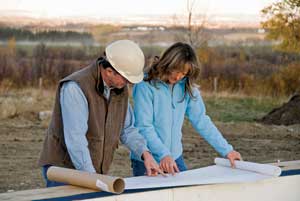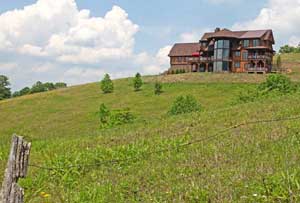Choosing to build on raw land allows you to find a site that appeals to you in terms of its views and scenery, and gives you infinitely more leeway to make aesthetic choices in your design.
The trade-off is that with every freedom afforded by raw land, you’re faced with potential challenges. Building on raw land is not simply a matter of picking a spot with a lovely view and plunking your home down on it. The good news, though, is that you can build on just about any spot, no matter how physically or logistically challenging — assuming your budget can meet these challenges.
Searching for Land

Searching for land for sale use a variety of methods to find available property, including scanning local newspapers, querying farmers in rural communities, and researching bank foreclosures, tax sales or evictions. A real estate agent is the best source for identifying sites, especially when your search covers an area far away from your current residence.
Once you’ve identified some candidates, your primary allies are due diligence and common sense. Plan to visit and walk over any property under consideration. You should also plan to investigate adjoining properties. In rural or unzoned areas, you’ll want to know whether there are large-scale farming operations that will affect potential value and your own quality of life.
Attorneys and Agents

A real estate agent should, of course, make clients aware of the surrounding conditions. Aside from showing you what’s on the market, it’s the real estate agent’s responsibility to inform you of material facts, such as easements or highway improvements.
Another key ally in buying raw land is a real estate attorney. A real estate attorney is equipped to search and interpret titles, and many local attorneys actually have the transactions in their community memorized. Attorneys will also have connections with title insurance companies, which insure you in the event of a defect or hindrance with your purchase. An attorney is also vital, of course, in drawing up a contract.
Experts Consultation

Mark Johnson, an architect based in Kalispell, Montana, feels that when you find a tract of raw land appealing enough to consider purchasing, you should consult at least one expert to help you assess the land. This can be a geotechnical engineer, a surveyor, an architect, or a designer. However, Johnson feels that your single best resource is a locally based landscape architect, “because they deal with the land itself. They can suggest good building spots and point out topographical irregularities.”
Sewer and Water
A health inspector will visit your site to conduct a test to establish the land’s rate of drainage. This will dictate where you can place your primary and repair drainage fields, or determine if you have to install a custom system.
It’s wise to evaluate your property for sewer septic concerns and to be sure that there is an adequate source of water to operate the system. Ask neighbors about their sewer and water issues. Find out how deep they had to dig for their well. Beware of lowlands or rocky soil. The county health department will be able to tell you how many feet away your septic field must be from water.
Electrical Connection

Electrical connection is generally more expensive than septic and water considerations. You don’t have to be that far away from the grid to have access problems.” You might be able to connect to lines on an adjoining property, but your neighbor has the sole right to grant or deny an easement.
Utility companies will send an engineer to a property to calculate the installation cost based on distance and number of poles. It’s also worth asking the local power company what expansion is planned and if they are willing to help subsidize installation in order to inspire future development.
Access to Roads

You’ll need to do some research in terms of road access, to make sure your property is not land-locked. You’ll need to factor in the cost of building one-time access, which might run into five figures. You’ll also want to investigate potential expansion of public roads on or around your desired site. The state department of transportation’s engineering department can answer your questions about future development.
Environmental regulation is another potential hindrance to where or how you can build. While beyond the scope of this article, be sure to ask your agent, attorney, neighbors, and regulatory agencies about these concerns.
Environmental Concerns
Be sure to ask your agent, attorney, neighbors, and regulatory agencies about these concerns.
Summary
With so many gray areas to contend with in the purchase of raw land, it might seem an overwhelming task. But if you wish to create a home that blends harmoniously with a natural environment, the rewards of wisely choosing a plot will be worth the effort.

